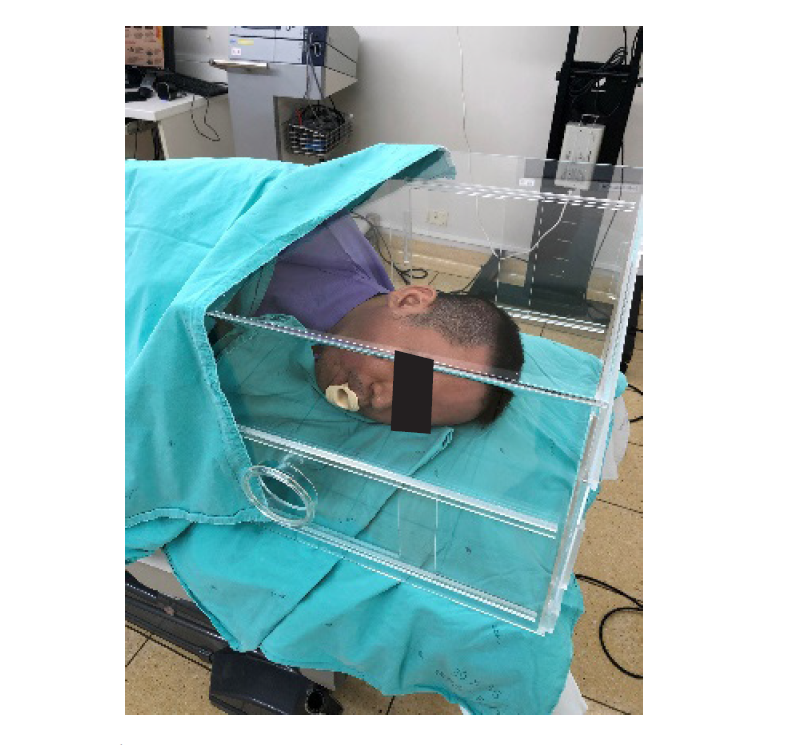Leak-Testing of an Endoscopic Aerosol Box for Preventing SARS-CoV-2 Infection during Upper Gastrointestinal Endoscopy
DOI:
https://doi.org/10.33192/Smj.2021.90Keywords:
SARS-CoV-2, Endoscopy, aerosol, barrier, aerosol generating procedureAbstract
Objective: The SARS-CoV-2 virus has infected many healthcare professionals. Endoscopy is an aerosol-generating procedure and the endoscopy team is at risk of exposure and infection. We describe the leak-testing of an aerosol box that uses a glove-covering for the endoscope.
Materials and Methods: An endoscopic aerosol box with a glove-covering over the endoscope was made for
gastroscopy, EUS and ERCP procedures and was tested for leakage of aerosol/airborne particles. Fine particulate matter (PM) from burnt incense sticks was used as a model for viral aerosol. The leakage from the box was measured by comparing readings from 2 PM light-scattering sensors, one placed inside the box and the other just outside the glove opening in a sealed container. Negative pressure conditions were also used to see if this had any effect on the leakage.
Results: The concentration levels of the particulate matter differed with different negative pressure conditions and movement of the endoscope through the glove. Very little leakage was seen with the endoscope stationary even with no negative pressure, at 2.4%, 0.17% and 0.07% for PM1, PM2.5 and PM10, respectively. The maximum leakage was 14% for PM1, 8.7% for PM2.5 and 2.6% for PM10 in the moving-endoscope condition and no negative pressure. This reduced to 6.2%, 1.3%and 0.37% respectively when suction was applied at full strength (negative pressure of -0.05 bar).
Conclusion: The glove covering significantly reduced the passage of particles. The particulate leak was seen most with the smallest particles and reached 14% for PM1 without negative pressure. This reduced to 6.2% with maximum negative pressure using the wall suction.
References
2. Zhang W, Du RH, Li B, Zheng XS, Yang XL, Hu B, et al. Molecular and serological investigation of 2019-nCoV infected patients: implication of multiple shedding routes. Emerg Microbes Infect. 2020;9(1):386-9.
3. Holshue ML, DeBolt C, Lindquist S, Lofy KH, Wiesman J, Bruce H, et al. First Case of 2019 Novel Coronavirus in the United States. N Engl J Med. 2020;382(10):929-36.
4. Xiao F, Tang M, Zheng X, Liu Y, Li X, Shan H. Evidence for Gastrointestinal Infection of SARS-CoV-2. Gastroenterology. 2020.
5. Xu H, Zhong L, Deng J, Peng J, Dan H, Zeng X, et al. High expression of ACE2 receptor of 2019-nCoV on the epithelial cells of oral mucosa. Int J Oral Sci. 2020;12(1):8.
6. Soetikno R, Teoh AY, Kaltenbach T, Lau JY, Asokkumar R, Cabral-Prodigalidad P, et al. Considerations in performing endoscopy during the COVID-19 pandemic. Gastrointest Endosc. 2020.
7. Ong J, Cross GB, Dan YY. Prevention of nosocomial SARS-CoV-2 transmission in endoscopy: international recommendations and the need for a gold standard. Gut. 2020.
8. Kongkam P, Tiankanon , K., Ratanalert , S., Janthakun, V., Kitiyakara , T., Angsuwatcharakon, P., Chantarojanasiri , T., Mekaroonkamol , P., Ridtitid , W., Aniwan , S., Pittayanon , R., Attasaranya , S., Linlawan , S., Pausawasdi , N., Akaraviputh , P. T., Ratanachu-ek , T., & Rerknimitr , P. R. The Practice of Endoscopy during the COVID-19 Pandemic:Recommendations from the Thai Association for Gastrointestinal Endoscopy (TAGE) In collaboration with the Endoscopy Nurse Society (Thailand) . . Siriraj Medical Journal. 2020;72(4):283-6.
9. Canelli R, Connor CW, Gonzalez M, Nozari A, Ortega R. Barrier Enclosure during Endotracheal Intubation. N Engl J Med. 2020.
10. Sagami R, Nishikiori H, Sato T, Murakami K. Endoscopic shield: barrier enclosure during the endoscopy to prevent aerosol droplets during the COVID-19 pandemic. VideoGIE. 2020.
11. Kagawa Y, Fukuzawa M, Itoi T. Novel dedicated plastic cube for infection prevention during gastrointestinal endoscopy and endoscopic retrograde cholangiopancreatography. Dig Endosc. 2020.
12. Ng C-L, Kai F-M, Tee M-H, Tan N, Hemond HF. A Prototype Sensor for In Situ Sensing of Fine Particulate Matter and Volatile Organic Compounds. Sensors. 2017;18(1):1-9.
13. Li Q, Guan X, Wu P, Wang X, Zhou L, Tong Y, et al. Early Transmission Dynamics in Wuhan, China, of Novel Coronavirus-Infected Pneumonia. N Engl J Med. 2020;382(13):1199-207.
14. Jin YH, Huang Q, Wang YY, Zeng XT, Luo LS, Pan ZY, et al. Perceived infection transmission routes, infection control practices, psychosocial changes, and management of COVID-19 infected healthcare workers in a tertiary acute care hospital in Wuhan: a cross-sectional survey. Mil Med Res. 2020;7(1):24.
15. Patel KP, Vunnam SR, Patel PA, Krill KL, Korbitz PM, Gallagher JP, et al. Transmission of SARS-CoV-2: an update of current literature. Eur J Clin Microbiol Infect Dis. 2020.
16. Prather KA, Wang CC, Schooley RT. Reducing transmission of SARS-CoV-2. Science. 2020;368(6498):1422-4.
17. Simpson JP, Wong DN, Verco L, Carter R, Dzidowski M, Chan PY. Measurement of airborne particle exposure during simulated tracheal intubation using various proposed aerosol containment devices during the COVID-19 pandemic. Anaesthesia. 2020.
18. Marchese M, Capannolo A, Lombardi L, Di Carlo M, Marinangeli F, Fusco P. Use of a Modified Ventilation Mask to Avoid Aerosolizing Spread of Droplets for Short Endoscopic Procedures during

Published
How to Cite
Issue
Section
License
Authors who publish with this journal agree to the following conditions:
Copyright Transfer
In submitting a manuscript, the authors acknowledge that the work will become the copyrighted property of Siriraj Medical Journal upon publication.
License
Articles are licensed under a Creative Commons Attribution-NonCommercial-NoDerivatives 4.0 International License (CC BY-NC-ND 4.0). This license allows for the sharing of the work for non-commercial purposes with proper attribution to the authors and the journal. However, it does not permit modifications or the creation of derivative works.
Sharing and Access
Authors are encouraged to share their article on their personal or institutional websites and through other non-commercial platforms. Doing so can increase readership and citations.














